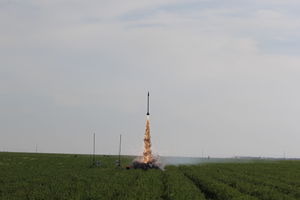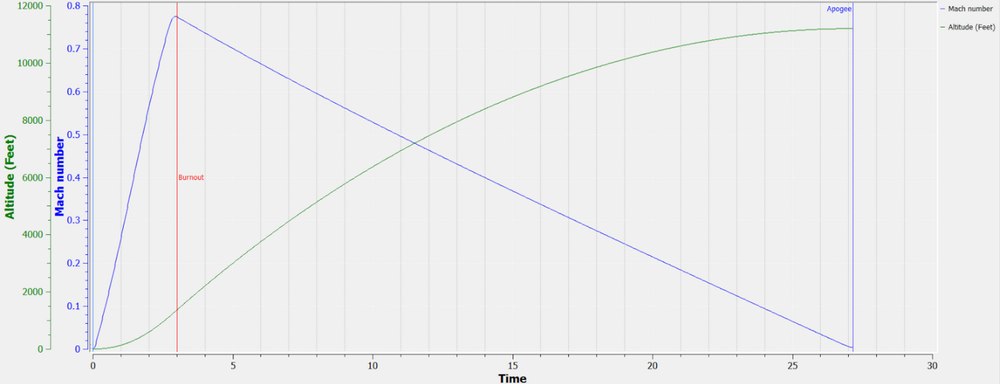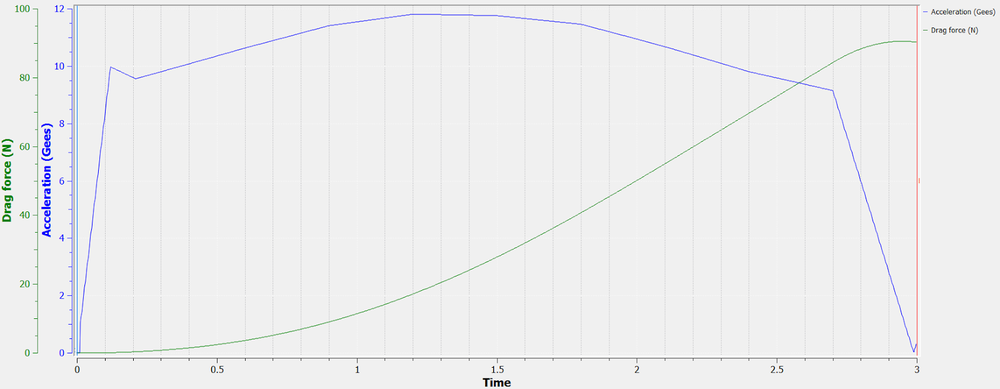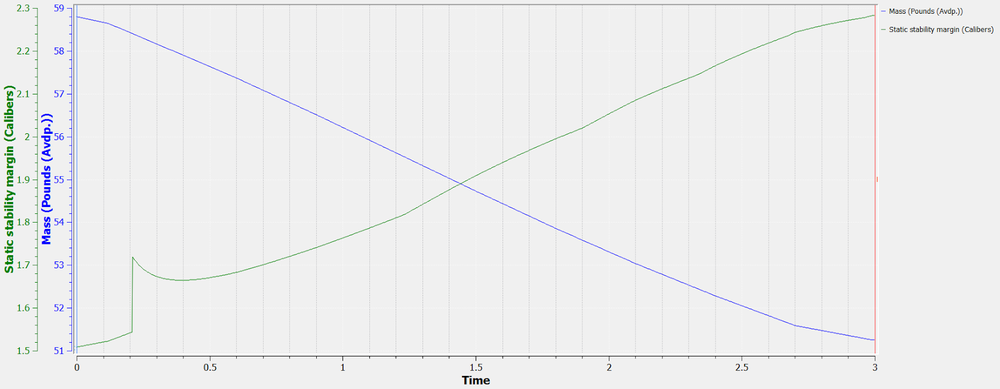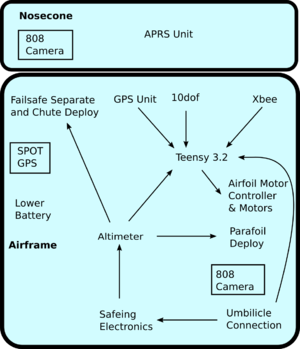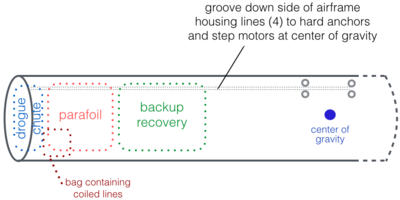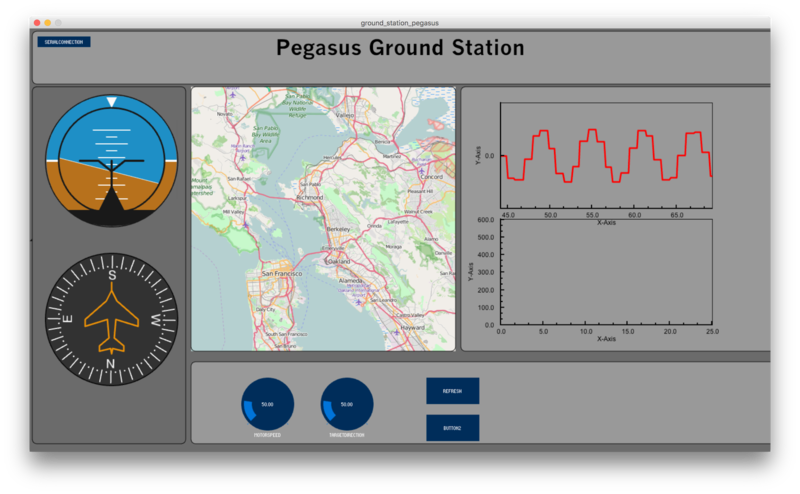Difference between revisions of "Pegasus"
| (46 intermediate revisions by 5 users not shown) | |||
| Line 1: | Line 1: | ||
| − | The Pegasus team is designing a rocket with the goal of demonstrating the feasibility of controlled recovery from high-powered flight from over 10,000 ft through the use of a parafoil. The team is currently working on the design of an L3 rocket to be launched on March 19, 2016 as well as an L1 to be launched on February 6, 2016, the purpose of which is to test the | + | The Pegasus team is designing a rocket with the goal of demonstrating the feasibility of controlled recovery from high-powered flight from over 10,000 ft through the use of a parafoil. The team is currently working on the design of an L3 rocket to be launched on March 19, 2016 as well as an L1 to be launched on February 6, 2016, the purpose of which is to test the ejection of the parafoil from the airframe. |
| + | {{rocket-project | ||
| + | | header = Pegasus (ARES-2) | ||
| + | | img link = File:Pegasus_Flag.png | ||
| + | | launch details = | ||
| + | |||
| + | {{rocket-launch | ||
| + | |number=1 | ||
| + | |launch class = L1 | ||
| + | |launch date = February 20, 2016 | ||
| + | |launch site = LUNAR | ||
| + | |next={{rocket-launch | ||
| + | |number=2 | ||
| + | |launch class = L2 | ||
| + | |launch date = Pending | ||
| + | |launch site = Pending | ||
| + | |next={{rocket-launch | ||
| + | |number=3 | ||
| + | |launch class = L3 | ||
| + | |launch date = Pending | ||
| + | |launch site = Pending | ||
| + | }} | ||
| + | }} | ||
| + | }} | ||
| + | |||
| + | | program = Project Daedalus | ||
| + | | last = Talos | ||
| + | | next = Charybdis | ||
| + | }} | ||
| − | |||
= Team Summary = | = Team Summary = | ||
| − | Ian Gomez (Project Manager), Marie Johnson (Team lead), Austin Pineault (Structural Development and Mechanical Systems Integration), Andrew Milich (Avionics, Deployment, and Programming), John Dean (Avionics, Deployment, and Programming), Hannah Williams (Structural Development and Parafoil) | + | Ian Gomez (Project Manager), Marie Johnson (Team lead), Austin Pineault (Structural Development and Mechanical Systems Integration), Andrew Milich (Avionics, Deployment, and Programming), John Dean (Avionics, Deployment, and Programming), Hannah Williams (Structural Development and Parafoil), Nate Simon (Parafoil and Aerodynamics). <br /> |
= Launch Vehicle and Payload Summary = | = Launch Vehicle and Payload Summary = | ||
| Line 11: | Line 38: | ||
The payload of this rocket is the active recovery system and its backup. The payload will be a parafoil deployed at apogee and controlled by two servos throughout descent. | The payload of this rocket is the active recovery system and its backup. The payload will be a parafoil deployed at apogee and controlled by two servos throughout descent. | ||
| + | |||
| + | = Launches and Tests = | ||
| + | |||
| + | == February 20 == | ||
| + | |||
| + | '''Pegasus 1:''' This was the first test flight of the Pegasus rocket where a parafoil was used instead of a parachute to safely land the rocket. The main purposes of this launch were to: | ||
| + | # Test out our idea to store the parafoil under the nose cone | ||
| + | # Take a video of parafoil deployment on the rocket to try and find any unforseen problems with our current design, folding technique for the parafoil. | ||
| + | |||
| + | |||
| + | ''Brief Rocket Design'' | ||
| + | The rocket measures 7.5ft long with a 4" OD. It is made of two phenolic airframes connected by an internal phenolic coupler 7" long. The three fins are fiberglass with a trapezoidal design and the nosecone is an ogive shape 18" long made of polystyrene. We had the parafoil stored under the nosecone and had the attachment lines running along the outside, lightly taped to the rocket with white duct tape.[[File:Pegasus1Launch.JPG|thumb|frame|right|300px|Pegasus 1 launching off the rod at TCC on Feb 20,2016]] Inside we custom built an avionics bay to contain and protect our SPOT trackers from the heat of the motor ejection charge. We decided to make this launch an ultra basic one where instead of using an altimeter to set off the charge at specified height. The holes through which which the parafoil is attached is 5"towards the aft of the coupler in the lower airframe. A 10dof had originally been planned to have on the parafoil, but there was not enough time to attach and secure the 10dof prior to launch. Lastly, a mini U8 camera was mounted on the aft airframe just above the fins to take video of the parafoil deployment. Initially, two were planned to be used, but one was loaned to another team and was not returned in time for the launch. | ||
| + | |||
| + | The motor that was chosen for this launch was a DMS I280 from Aerotech. This was because it closely mimicked the speed off the rod and average thrust of our predicted final rocket motor. The I280 that was purchased included Magnesium in its propellant to create the sparkling flame trail behind the rocket. | ||
| + | |||
| + | |||
| + | ''Results'' | ||
| + | |||
| + | This launch successfully displayed that storing the parafoil underneath the nosecone is a very feasible option. There was no initial tangling of the lines over the parafoil, however a problem of the lines becoming twisted around each other was shown to be a serious concern for when control lines are invariably added to each 'flaperon' on the parafoil. The launch also demonstrated that we had correctly sized the parafoil to our rocket weight, and could even safely add weight, as the landing was extremely soft and the rocket experienced no damage upon touchdown. | ||
= Vehicle Criteria = | = Vehicle Criteria = | ||
| Line 40: | Line 86: | ||
== Propulsion System == | == Propulsion System == | ||
| − | The Cesaroni M1450 was chosen because it is commercially available, reloadable, complies with the Tripoli and California restrictions, keeps our rocket sub Mach-1, and should achieve a maximum height | + | The Cesaroni M1450 was chosen because it is commercially available, reloadable, complies with the Tripoli and California restrictions, keeps our rocket sub Mach-1, and should achieve a maximum height to a safe margin below the maximum ceiling. Thus even if our mass budget increases, there will still be ample altitude to test the parafoil system. |
| − | The M1450 has an average thrust of 1500 N, a total impulse of 10000 N-s, a specific impulse of 210 s, a burn time of 6.9 s | + | The M1450 has an average thrust of 1500 N, a total impulse of 10000 N-s, a specific impulse of 210 s, and a burn time of 6.9 s. |
| − | === | + | === Flight Characteristics === |
| − | + | With current mass budget considerations, the M1450 motor is projected to boost the rocket to a peak of roughly Mach 0.78 and an apogee of roughly 11000 ft after 27 s. | |
| + | [[File:Pegasus_Performance_Altitude_Speed.png|thumb|frame|center|1000px|Altitude and Mach variation throughout the flight]] | ||
| − | + | On liftoff, the acceleration of the rocket is projected to be roughly 10 g, increasing to a sustained 11.5 g. A maximum drag force of roughly 85 N is expected. Max-Q is expected to occur roughly 4 s into the flight. | |
| + | [[File:Pegasus_Performance_Acceleration_Drag.png|thumb|frame|center|1000px|Acceleration and drag forces on the rocket during the motor firing]] | ||
| − | + | A nominal static stability ranging between 1.5 and 2.3 calibers is expected in the current configuration. | |
| − | + | [[File:Pegasus_Performance_Mass_Stability.png|thumb|frame|center|1000px|Mass decrease and change in static stability during the motor firing]] | |
| − | [[File: | ||
| − | |||
| − | |||
| − | |||
| − | |||
| − | |||
| − | |||
| − | |||
== Structural Design == | == Structural Design == | ||
| Line 76: | Line 116: | ||
The forward airframe will be 6“ in diameter and 44” in length. It will house, from front to rear, the primary recovery system (parafoil), backup recovery system (parachute payload), and avionics bay. | The forward airframe will be 6“ in diameter and 44” in length. It will house, from front to rear, the primary recovery system (parafoil), backup recovery system (parachute payload), and avionics bay. | ||
| − | [[File: | + | [[File:Pegasus_Parafoil_Structural_Overview.png|thumb|frame|center|600px|Structural overview for parafoil storage in forward airframe]] |
| − | |||
Each of these components will be separated by bulkheads; the foreward bulkhead is designed to protect the backup recovery system from the parafoil’s expulsion and will be mobile (supported on the aft side by blocks along the inner wall of the airframe) to allow backup system to exit the rocket, while the aft bulkhead is designed to protect the avionics and therefore will be stationary. | Each of these components will be separated by bulkheads; the foreward bulkhead is designed to protect the backup recovery system from the parafoil’s expulsion and will be mobile (supported on the aft side by blocks along the inner wall of the airframe) to allow backup system to exit the rocket, while the aft bulkhead is designed to protect the avionics and therefore will be stationary. | ||
| Line 99: | Line 138: | ||
Telemetry is accomplished using two XBee 9B 900MHZ 250MW long range radio transmitters. Under line of sight conditions, these are expected to achieve a maximum range of 28 miles. We equipped both with 900 MHZ, low impedance, RP-SMA duck antennas. | Telemetry is accomplished using two XBee 9B 900MHZ 250MW long range radio transmitters. Under line of sight conditions, these are expected to achieve a maximum range of 28 miles. We equipped both with 900 MHZ, low impedance, RP-SMA duck antennas. | ||
| − | [[File: | + | [[File:Pegasus_Avionics_Block_Diagram.png|thumb|300px|right|Avionics block diagram]] |
=== Avionics Teensy Pinout === | === Avionics Teensy Pinout === | ||
| Line 108: | Line 147: | ||
The in-flight tracking will use a XBee Pro module and an Adafruit GPS receiver with a ceramic antena. | The in-flight tracking will use a XBee Pro module and an Adafruit GPS receiver with a ceramic antena. | ||
| + | |||
| + | [[File:Pegasus_Avionics_XBee.png|80px]] | ||
For the in-flight communication and redundant tracking, the rocket will rely on live communication via XBee transmitters and the use of a small SPOT GPS for precise location of the rocket. | For the in-flight communication and redundant tracking, the rocket will rely on live communication via XBee transmitters and the use of a small SPOT GPS for precise location of the rocket. | ||
| Line 120: | Line 161: | ||
The parafoil is going to be stored directly behind the nosecone within the forward airframe. The majority of the attachment and support lines are going to be folded in with the parafoil with the four main lines leading out of the nosecone and down the outside of the airframe. These four lines are the two control and two load bearing lines respectively. Each of these four lines is to be inserted through its own slot in the foreward/aft airframes where it is attached to the inside of the rocket near the CG. | The parafoil is going to be stored directly behind the nosecone within the forward airframe. The majority of the attachment and support lines are going to be folded in with the parafoil with the four main lines leading out of the nosecone and down the outside of the airframe. These four lines are the two control and two load bearing lines respectively. Each of these four lines is to be inserted through its own slot in the foreward/aft airframes where it is attached to the inside of the rocket near the CG. | ||
| + | |||
| + | [[File:Pegasus_Parafoil_Storage.png|thumb|frame|center|400px|Bulkhead and backup separation design]] | ||
=== Deployment === | === Deployment === | ||
| Line 141: | Line 184: | ||
* Other simple applications to monitor range or other basic parameters. | * Other simple applications to monitor range or other basic parameters. | ||
| − | [[File: | + | [[File:Pegasus_Avionics_Ground_Station.png|800px|center]] |
=== Landing === | === Landing === | ||
| Line 158: | Line 201: | ||
Upon the need for the backup recovery system, a pyrodex ejection charge located behind the parachute will be ignited from a command given by the altimeter. This charge will force out the parachute, pushing the movable bulkhead out of the forward airframe with it. Since the shockcord is going to be traveling a large distance within the rocket, the shockcord will have a tennis ball around it to mitigate possible zippering of the rocket. | Upon the need for the backup recovery system, a pyrodex ejection charge located behind the parachute will be ignited from a command given by the altimeter. This charge will force out the parachute, pushing the movable bulkhead out of the forward airframe with it. Since the shockcord is going to be traveling a large distance within the rocket, the shockcord will have a tennis ball around it to mitigate possible zippering of the rocket. | ||
| + | |||
| + | [[File:Pegasus_Design_Bulkheads.png|thumb|frame|center|600px|Bulkhead and backup separation design]] | ||
= Manufacturing and Assembly = | = Manufacturing and Assembly = | ||
| Line 178: | Line 223: | ||
== Safety Hazards == | == Safety Hazards == | ||
| − | For this rocket using a parafoil recovery system creates most of the possible risks of having an unsuccessful flight. Our first risk is the parafoil not deploying properly. This could mean not emerging from the rocket, becoming tangled upon exit of the airframe, and becoming tangled in mid-air while opening. To mitigate the first issue, non-emergence, we are performing pre-launch date small scale tests to practice our system and amount of propellant needed to fully expel the parafoil. The second issue of becoming tangled upon exit we will also be performing small scale tests on prior to the full L3 rocket. This test will be performed again using a static run on the L3 to make sure we scaled it up properly. The final issue of becoming tangled while opening will also be examined through the small scale L1-L2 tests and should be mitigated depending on how the parafoil is folded and fit into the rocket airframe. The parafoil is also going to be contained in a freebag that will be pulled out by the drogue chute. This combination should also help prevent the other issues upon exit. In the event that all of this fails, the payload for the rocket is a parachute that is rigged to an altimeter. Upon too quick of a descent (aka parafoil mal-deployment) the parachute will deploy prematurely to slow the descent of the rocket to a safe speed of 20 | + | For this rocket using a parafoil recovery system creates most of the possible risks of having an unsuccessful flight. Our first risk is the parafoil not deploying properly. This could mean not emerging from the rocket, becoming tangled upon exit of the airframe, and becoming tangled in mid-air while opening. To mitigate the first issue, non-emergence, we are performing pre-launch date small scale tests to practice our system and amount of propellant needed to fully expel the parafoil. The second issue of becoming tangled upon exit we will also be performing small scale tests on prior to the full L3 rocket. This test will be performed again using a static run on the L3 to make sure we scaled it up properly. The final issue of becoming tangled while opening will also be examined through the small scale L1-L2 tests and should be mitigated depending on how the parafoil is folded and fit into the rocket airframe. The parafoil is also going to be contained in a freebag that will be pulled out by the drogue chute. This combination should also help prevent the other issues upon exit. In the event that all of this fails, the payload for the rocket is a parachute that is rigged to an altimeter. Upon too quick of a descent (aka parafoil mal-deployment) the parachute will deploy prematurely to slow the descent of the rocket to a safe speed of 20 m/s. |
The second point of risk is when the rocket is descending while being controlled by the parafoil and the step motors. There is always a possibility of having strong winds above 10,000ft and gusts could cause major control issues for both the stepper motors and for the coded flight plan. Some fail-safes are put into place such as having overly robust stepper motors so that under larger-than-predicted forces the stepper motors will not fail. Another safe-guard are pre-written statements that are associated with the parachute. These safe-guards include too quick of a descent rate (parafoil failure), prolonged ascension after the rocket has reached apogee (in case of thermals or wind gusts forcing the parafoil upwards). | The second point of risk is when the rocket is descending while being controlled by the parafoil and the step motors. There is always a possibility of having strong winds above 10,000ft and gusts could cause major control issues for both the stepper motors and for the coded flight plan. Some fail-safes are put into place such as having overly robust stepper motors so that under larger-than-predicted forces the stepper motors will not fail. Another safe-guard are pre-written statements that are associated with the parachute. These safe-guards include too quick of a descent rate (parafoil failure), prolonged ascension after the rocket has reached apogee (in case of thermals or wind gusts forcing the parafoil upwards). | ||
| Line 208: | Line 253: | ||
; March 19th: | ; March 19th: | ||
: L3 Launch | : L3 Launch | ||
| − | |||
| − | |||
| − | |||
| − | |||
| − | |||
| − | |||
| − | |||
| − | |||
| − | |||
| − | |||
| − | |||
| − | |||
| − | |||
| − | |||
| − | |||
| − | |||
| − | |||
| − | |||
| − | |||
| − | |||
| − | |||
| − | |||
| − | |||
| − | |||
| − | |||
| − | |||
| − | |||
| − | |||
| − | |||
| − | |||
| − | |||
| − | |||
| − | |||
| − | |||
| − | |||
| − | |||
| − | |||
| − | |||
| − | |||
| − | |||
| − | |||
| − | |||
| − | |||
| − | |||
| − | |||
| − | |||
| − | |||
| − | |||
| − | |||
| − | |||
| − | |||
| − | |||
| − | [[Category:Rockets]] | + | [[Category: Daedalus]] |
| + | [[Category: Rockets]] | ||
| + | [[Category: Documentation]] | ||
Latest revision as of 14:46, 15 September 2017
The Pegasus team is designing a rocket with the goal of demonstrating the feasibility of controlled recovery from high-powered flight from over 10,000 ft through the use of a parafoil. The team is currently working on the design of an L3 rocket to be launched on March 19, 2016 as well as an L1 to be launched on February 6, 2016, the purpose of which is to test the ejection of the parafoil from the airframe.
| Pegasus (ARES-2) | ||||
|---|---|---|---|---|

| ||||
| Launch 1 - L1 | ||||
| Launch date | February 20, 2016 | |||
| Launch site | LUNAR | |||
| Launch 2 - L2 | ||||
| Launch date | Pending | |||
| Launch site | Pending | |||
| Launch 3 - L3 | ||||
| Launch date | Pending | |||
| Launch site | Pending | |||
| ||||
Team Summary
Ian Gomez (Project Manager), Marie Johnson (Team lead), Austin Pineault (Structural Development and Mechanical Systems Integration), Andrew Milich (Avionics, Deployment, and Programming), John Dean (Avionics, Deployment, and Programming), Hannah Williams (Structural Development and Parafoil), Nate Simon (Parafoil and Aerodynamics).
Launch Vehicle and Payload Summary
The purpose of the Pegasus rocket is to demonstrate the feasibility of using a parafoil recovery system to create a controlled, directed recovery for a high-powered rocket from over 10,000 ft.
The payload of this rocket is the active recovery system and its backup. The payload will be a parafoil deployed at apogee and controlled by two servos throughout descent.
Launches and Tests
February 20
Pegasus 1: This was the first test flight of the Pegasus rocket where a parafoil was used instead of a parachute to safely land the rocket. The main purposes of this launch were to:
- Test out our idea to store the parafoil under the nose cone
- Take a video of parafoil deployment on the rocket to try and find any unforseen problems with our current design, folding technique for the parafoil.
Brief Rocket Design
The rocket measures 7.5ft long with a 4" OD. It is made of two phenolic airframes connected by an internal phenolic coupler 7" long. The three fins are fiberglass with a trapezoidal design and the nosecone is an ogive shape 18" long made of polystyrene. We had the parafoil stored under the nosecone and had the attachment lines running along the outside, lightly taped to the rocket with white duct tape.
Inside we custom built an avionics bay to contain and protect our SPOT trackers from the heat of the motor ejection charge. We decided to make this launch an ultra basic one where instead of using an altimeter to set off the charge at specified height. The holes through which which the parafoil is attached is 5"towards the aft of the coupler in the lower airframe. A 10dof had originally been planned to have on the parafoil, but there was not enough time to attach and secure the 10dof prior to launch. Lastly, a mini U8 camera was mounted on the aft airframe just above the fins to take video of the parafoil deployment. Initially, two were planned to be used, but one was loaned to another team and was not returned in time for the launch.
The motor that was chosen for this launch was a DMS I280 from Aerotech. This was because it closely mimicked the speed off the rod and average thrust of our predicted final rocket motor. The I280 that was purchased included Magnesium in its propellant to create the sparkling flame trail behind the rocket.
Results
This launch successfully displayed that storing the parafoil underneath the nosecone is a very feasible option. There was no initial tangling of the lines over the parafoil, however a problem of the lines becoming twisted around each other was shown to be a serious concern for when control lines are invariably added to each 'flaperon' on the parafoil. The launch also demonstrated that we had correctly sized the parafoil to our rocket weight, and could even safely add weight, as the landing was extremely soft and the rocket experienced no damage upon touchdown.
Vehicle Criteria
Mission Statement
The Pegasus Rocket team is seeking to develop an efficient and reliable recovery system for high-powered rockets that utilizes a parafoil instead of a parachute.
Mission Success Criteria
The mission will be considered successful if the recovered rocket would be able to pass a L3 certification inspection. This means that if the rocket experiences excessive damage to the point that it could not be re-flown that day with a reloaded motor, then the recovery system will have failed. Another criteria is that the rocket will have landed within a 300ft radius of its original target landing space.
Constraints
- Tripoli height ceiling of 16,800 ft
- Rocket construction to be made using a “minimum of metallic parts” excepting those necessary for airframe integrity
- Motor impulse to not exceed 10,240 N-s
- Redundant avionics, wiring, and safe arm systems
- Automated program for descent path
- Manual back up control system for descent path
- Back up recovery system consisting of main parachute
- Vertical descent speed of 20 ft/s maximum upon landing
- Budget
System Overview
Moments after reaching apogee, a parafoil will deployed from the nosecone of the Firestorm rocket. Structural and control lines of the parafoil will be secured on the exterior of the rocket. Using stepper motors and an XBee, the rocket will be monitored and controlled during descent. This includes real-time data monitoring of position, velocity, vertical speed, and system status as well as options to steer or flare the system. Initially, this will be limited to simple guidance motions such as left or right turns, or flare using both control surfaces simultaneously.
Propulsion System
The Cesaroni M1450 was chosen because it is commercially available, reloadable, complies with the Tripoli and California restrictions, keeps our rocket sub Mach-1, and should achieve a maximum height to a safe margin below the maximum ceiling. Thus even if our mass budget increases, there will still be ample altitude to test the parafoil system.
The M1450 has an average thrust of 1500 N, a total impulse of 10000 N-s, a specific impulse of 210 s, and a burn time of 6.9 s.
Flight Characteristics
With current mass budget considerations, the M1450 motor is projected to boost the rocket to a peak of roughly Mach 0.78 and an apogee of roughly 11000 ft after 27 s.
On liftoff, the acceleration of the rocket is projected to be roughly 10 g, increasing to a sustained 11.5 g. A maximum drag force of roughly 85 N is expected. Max-Q is expected to occur roughly 4 s into the flight.
A nominal static stability ranging between 1.5 and 2.3 calibers is expected in the current configuration.
Structural Design
The complete launch vehicle can be broken-down into three primary sections: nose cone, forward airframe, and aft airframe.
Nose Cone
A fiberglass nose cone will be used. A custom lay-up of fiberglass will be used to control the exact aerodynamic profile and meet the diameter requirements of the rocket.
Forward Airframe
The forward airframe will be 6“ in diameter and 44” in length. It will house, from front to rear, the primary recovery system (parafoil), backup recovery system (parachute payload), and avionics bay.
Each of these components will be separated by bulkheads; the foreward bulkhead is designed to protect the backup recovery system from the parafoil’s expulsion and will be mobile (supported on the aft side by blocks along the inner wall of the airframe) to allow backup system to exit the rocket, while the aft bulkhead is designed to protect the avionics and therefore will be stationary.
Aft Airframe
The aft airframe will be 6“ in diameter and 48” in length, and will house the motor retainer and fins, as well as have aft attachment points for the coupler.
Fins
There are going to be three fins for this rocket. We are going to be using a trapezoidal design with a root length of 12“ and a tip of 6”. They are to have a span of roughly 12“, a leading sweep of 60, and a trailing sweep of 20. This design choice was made to keep the CP within the ”rule of thumb" 1-2 diameter distance between the CP and CG that generates correct stability. However, there is a concern with how the trailing ends of the fins, which extend beyond the aft end of the rocket, will incur damage upon landing.
This possibility of damage is to be mitigated by the material choice for the fins. Aluminum is currently the best choice, for resistance to deformation upon landing, malleability and ease of machining, as well as being relatively lightweight.
Materials
There will be a variety of materials used for the Pegasus rocket. For the airframes we are currently considering to either use polycarbonate due to its structural qualities. However, we are also considering phenolic for the airframes. The nosecone will be made of fiberglass because it is lightweight and strong as well as relatively easy to shape into smooth and specific designs, such as an ogive nosecone. The fins are currently going to be made from aluminum unless a structural equivalent can be found from a non-metal material. Inner support and structures to hold the motors and avionics will be made from a mixture of wood and aluminum bulkheads, as well as some structural support from aluminum struts.
Avionics and Telemetry
Telemetry is accomplished using two XBee 9B 900MHZ 250MW long range radio transmitters. Under line of sight conditions, these are expected to achieve a maximum range of 28 miles. We equipped both with 900 MHZ, low impedance, RP-SMA duck antennas.
Avionics Teensy Pinout
A Teensy 3.2 microncontroller served as the principal brains of the rocket due to considerable size and performance advantages compared to Arduino based platforms. Through software serial, it communicated directly with the XBee (and thus the ground station) while reading from the GPS and 10DOF sensors as well.
In-Flight Tracking
The in-flight tracking will use a XBee Pro module and an Adafruit GPS receiver with a ceramic antena.
For the in-flight communication and redundant tracking, the rocket will rely on live communication via XBee transmitters and the use of a small SPOT GPS for precise location of the rocket.
Power Sources and Budget
Due to high power density and low weight, we chose to use a Lithium Polymer battery. As stepper motors require relatively high amounts of voltage and current, we chose a two cell, 7.4 V LiPo. As the motor’s burn time is relatively short, a battery with low mAh was suitable for these applications. This battery is required to power the Teensy, XBee, stepper motors, and sensors used for guidance.
Parafoil System
Storage and Attachment
The parafoil is going to be stored directly behind the nosecone within the forward airframe. The majority of the attachment and support lines are going to be folded in with the parafoil with the four main lines leading out of the nosecone and down the outside of the airframe. These four lines are the two control and two load bearing lines respectively. Each of these four lines is to be inserted through its own slot in the foreward/aft airframes where it is attached to the inside of the rocket near the CG.
Deployment
Deployment is going to be the result of a pyrodex ejection charge that pushes off the nosecone and a drogue chute. This drogue chute then pulls out the parafoil, allowing it to open in a more controlled manner which should reduce the possibility of lines getting tangled. This should also minimize the possibility of the parafoil becoming wrapped around the airframe due to axial spin.
Guidance
We developed a series of in-flight maneuvers used for our initial L1 launch. These can be selected at any time during descent in the Python or Processing ground stations. All allow the selection of a specific period of time and were tested during initial systems experiments.
- Turn Left: Turning left requires opposite directional movement of the two stepper motors for a period of time. During this time, the steppers are first rotated in opposite directions an equal number of steps. For the remainder of the time, the stepper motors maintain position in the turning state. A short period before the time expires, they are returned to the initial state by rotating back the same number of steps.
- Turn right: This is accomplished in the same manner as above.
- Flare: Flaring requires a fairly similar maneuver. Instead of rotating opposite directions, the two stepper motors are both rotated in the same direction to increase lift and drag. This causes the parafoil to slow down and momentarily reduce the rate of descent.
Ground Station
The ARES-2 Ground Station will include two equivalently functional pieces of software for GUI or text based monitoring and control of the rocket. This includes, but is not limited to:
- A Processing GUI with in-flight instruments, real-time mapping, and graphical renderings of system status (such as velocity, vertical speed, or heading).
- A simple Python text-based monitoring application to continually log data and send basic commands (for example, ’turn right for 15 seconds’) to the rocket.
- Other simple applications to monitor range or other basic parameters.
Landing
There are two landing procedures possible with this rocket. The first is by flaring the parafoil upon the approach of the ground, similar to how airplanes and skydivers land. This would be performed by using the “flaring” procedure described in the Guidance section. The second is by deploying the backup parachute. This option would be used if the ability to flare the parafoil is deemed ineffective by prior testing. The backup parachute would then be deployed at around 600ft. This height would give the parachute enough time to decrease the speed of the rocket to an acceptable landing speed of 20 ft/s.
Backup Recovery System
Backup Recovery Purpose
The backup Recovery system for the Pegasus rocket is also its payload. This system has a dual purpose: to become the main source of safe recovery upon a possible failure of the parafoil due to twisting, wrapping, and breakage, or as the second, and final, stage of recovery to drop the rocket down to its predesignated landing site. This last purpose may, or may not, become used as it is pending upon how well we are able to flare the ends of the parafoil in order to slow down the rocket and have a controlled touchdown.
Backup Recovery System Design
The backup recovery system is to consist of a main parachute and a shockcord attached to a hardpoint within the rocket airframes. The parachute is going to be located inside of the inner tube that provides the resting point for the movable bulkhead.
Upon the need for the backup recovery system, a pyrodex ejection charge located behind the parachute will be ignited from a command given by the altimeter. This charge will force out the parachute, pushing the movable bulkhead out of the forward airframe with it. Since the shockcord is going to be traveling a large distance within the rocket, the shockcord will have a tennis ball around it to mitigate possible zippering of the rocket.
Manufacturing and Assembly
For all of the testing, kits and other pre-made parts are going to be bought and modified in house. For the final L3, CAD will be sent out to make parts, such as the fiberglass nosecone that we are unable to make in house. The airframe tubes are going to be purchased, however modifications to them, such as cutting and reinforcement, will be done in house. The fins may also be made in house pending time. The parafoil and other recovery parts are going to be purchased through reliable vendors.
Systems Integration and Testing
Major Vehicle Launch Dates
- February 6th
- Launch test for parafoil deployment at 2,000ft using scale version of L3 rocket
- February 20th
- 2nd Major Launch test for avionics system and refining of parafoil deployment
- March 19th
- L3 Launch
Risk Management
Safety Hazards
For this rocket using a parafoil recovery system creates most of the possible risks of having an unsuccessful flight. Our first risk is the parafoil not deploying properly. This could mean not emerging from the rocket, becoming tangled upon exit of the airframe, and becoming tangled in mid-air while opening. To mitigate the first issue, non-emergence, we are performing pre-launch date small scale tests to practice our system and amount of propellant needed to fully expel the parafoil. The second issue of becoming tangled upon exit we will also be performing small scale tests on prior to the full L3 rocket. This test will be performed again using a static run on the L3 to make sure we scaled it up properly. The final issue of becoming tangled while opening will also be examined through the small scale L1-L2 tests and should be mitigated depending on how the parafoil is folded and fit into the rocket airframe. The parafoil is also going to be contained in a freebag that will be pulled out by the drogue chute. This combination should also help prevent the other issues upon exit. In the event that all of this fails, the payload for the rocket is a parachute that is rigged to an altimeter. Upon too quick of a descent (aka parafoil mal-deployment) the parachute will deploy prematurely to slow the descent of the rocket to a safe speed of 20 m/s.
The second point of risk is when the rocket is descending while being controlled by the parafoil and the step motors. There is always a possibility of having strong winds above 10,000ft and gusts could cause major control issues for both the stepper motors and for the coded flight plan. Some fail-safes are put into place such as having overly robust stepper motors so that under larger-than-predicted forces the stepper motors will not fail. Another safe-guard are pre-written statements that are associated with the parachute. These safe-guards include too quick of a descent rate (parafoil failure), prolonged ascension after the rocket has reached apogee (in case of thermals or wind gusts forcing the parafoil upwards).
Further safe-guards are the pre-launch weather requirements. Due to the nature of the recovery system and understanding that parafoils can become rather difficult to control above certain windspeeds, the Pegasus will not plan to launch when the ground windspeed exceeds 15mph. Under these types of conditions it is not unreasonable to assume that the windspeed above 10,000ft could be close to, if not greater than, 40mph; which is too high for the recovery system to be able to be properly controlled in a successful and reliable manner by the step motors.
Budget Risks
Our current total budget for Pegasus is $4000. Most of this will be going towards the purchases of our L3 components. Currently, our projected expenditures are below that budget limit. The largest budget “risk” would be testing expenses. It is easier to predict how much the L3 components are going to cost rather than the testing because extra tests might need to be run if we come upon unexpected problems, or are simply desirous of more testing before launching the L3. For this reason, we have allocated $690 as an overhead for testing costs and unforseen, but necessary, purchases. Due to the scale of the rocket and the cost of materials we are using, it is highly unlikely that the team will burn through the entire reserve fund.
Activity Plan
Timeline
- January 23rd
- Small scale ground ejection tests completed.
- January 30th
- Small scale rocket fully assembled
- February 6th
- Launch test for parafoil deployment at 2,000ft using scale version of L3 rocket
- February 13th
- APRS transmitter, GPS ground station and XBee controller built
- February 20th
- 2nd Major Launch test for avionics system and refining of parafoil deployment
- March 5th
- Optional extra launch test if necessary to continue refining systems
- March 12th
- Finish assembly of L3 rocket
- March 19th
- L3 Launch
